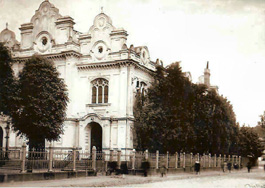
Latvian synagogues destroyed by the Nazis "came to life" at least as models
 |
| Great Choral Synagogue, Riga; source: museumoffamilyhistory.com |
Before World War II, there were 210 synagogues in Latvia - from modest wooden shrines to buildings in ornate Neo-Renaissance or Neo-Romanesque styles. Currently, only two operate in this Baltic country: one in Riga and the other in southern Latvia's Daugavpils. Now, under the patronage of the Riga Ghetto and Holocaust Museum in Latvia, 21 models of synagogues have been created from paper, wood, and plastic. They were built thanks to archival sources, official records, photographs, and detective work.
"They were places where life flourished," quotes Reuters the museum director, Rabbi Menachem Barkahan.
Among the 1:50 scale models is the former largest Jewish shrine in Riga, the Great Choral Synagogue from the 19th century. In 1941, it was completely burned down by the Nazis, but before that, at least 300 Jews were herded into its basement.
In now approximately two million Latvia, nearly 100,000 Jews lived before the war; currently, that number is at most 7,000. After the Nazi invasion in 1941, about 70,000 Latvian Jews and 25,000 Jews from Western Europe, who were deported here, were murdered.
Reuters recalls that in recent years, Riga has witnessed parades of former Latvian members of Nazi SS units, who claim they fought against the return of the Soviet Red Army. They deny having participated in the extermination of Jews, which was carried out by German units and their local collaborators.
The English translation is powered by AI tool. Switch to Czech to view the original text source.
0 comments
add comment












